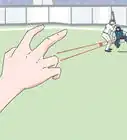wikiHow is a “wiki,” similar to Wikipedia, which means that many of our articles are co-written by multiple authors. To create this article, 13 people, some anonymous, worked to edit and improve it over time.
This article has been viewed 143,670 times.
Learn more...
ERA (Earned Run Average) is the average number of earned runs a pitcher has allowed per every 9 innings he pitches.[1] This is one of the most useful calculations in baseball, as it shows the pitcher's overall effectiveness.
Steps
Understanding Earned Run Average
-
1Know a bit more about earned run average. Earned run average is the number of times a man from the opposing scores a run due to the fault of the pitcher. This could be because of three things:
- The batter made a hit. Although it does mean the pitcher threw a strike, it counts against his earned run average.
- The pitcher walked the batter. This could be the result of the pitcher throwing four balls or hitting the batter with the pitch.
-
2Understand the rules. To calculate an accurate ERA, you must have accurate numbers. You need to know the earned runs, but to do this you have to look at when the pitcher was pulled from a game. For example, if a pitcher played three innings and in the fourth inning allowed a man on every base and then was pulled, all three of those men would count against his ERA. They do not transfer to the next pitcher simply because he was the one pitching when they made it across home plate.Advertisement
-
3Make sure you don't count unearned runs in your calculations. Whereas earned runs are caused by hits and are the fault of the pitcher, unearned runs are usually caused by errors or passed balls and are not strictly the fault of the pitcher. Unearned runs do not count towards a pitcher's ERA.[2]
- For example, there are runners on 2nd and 3rd base, with 2 outs. The pitcher throws a pitch to the batter, which ends up being a routine ground ball to the first baseman, but the first baseman bobbles it and can't make a play to get an out. One runner scores, and two are still left on base. The run is unearned, and if the two remaining runners on base happen to score, their runs also count as unearned.
-
4Know the required fields. To calculate ERA, you need three parts: the earned runs, the innings pitched, and the total number of innings.
- Earned runs, as explained above, are the number of times a pitcher lets a batter get on base. This is the total number for the whole game.
- The innings pitched is just like it sounds, the total number of innings this pitcher pitched. This number will always end in thirds. That is because for every inning three strikes can be made by the fielding team. That leaves three possible outcomes: a whole inning (three outs), an inning with two outs (ends in .66), or an inning with one out (ends in .33).
- The total number of innings refers to the number of innings in a complete game (9).[3]
Calculating Earned Run Average
-
1Gather your information. You will have three numbers to use in your calculation. For example, say that Joe Smith plays for 6 innings in a 9-inning game and allows 3 men to score.
-
2Make the first calculation. For this, divide the number of earned runs by the number of innings played. Following our example, it would be 3/6, giving us the number .5.
-
3Multiply this number with the total number of innings. That means we would take our number of .5 and multiply it with 9, giving us 4.5.
-
4Test your number. Depending on your preference, you can calculate ERA two ways. The first (shown above) is ERA= total innings(earned runs / innings pitched). You can also formulate it as ERA = earned runs x total number of innings / innings pitched. Test your answer using the alternate method.[4]
Community Q&A
-
QuestionA buddy of mine started an inning, walked the bases full, then got pulled out. The guy after him cashed in all his runs. That's the first and only time my buddy has pitched. What's his ERA?
 DonaganTop AnswererIf -- as it sounds -- your friend never got an out, that means he worked zero innings officially, and that means his ERA (so far) is infinity.
DonaganTop AnswererIf -- as it sounds -- your friend never got an out, that means he worked zero innings officially, and that means his ERA (so far) is infinity. -
QuestionWhat would it be for 12 innings, 1 run off error?
 DonaganTop AnswererIf no earned runs were allowed, the ERA is zero.
DonaganTop AnswererIf no earned runs were allowed, the ERA is zero. -
QuestionCan a pitcher make a fielding error?
 Community AnswerAbsolutely. If a weak ground ball is hit and the pitcher bobbles the ball while fielding it, making the throw to first for the out late, he receives an E1.
Community AnswerAbsolutely. If a weak ground ball is hit and the pitcher bobbles the ball while fielding it, making the throw to first for the out late, he receives an E1.
Warnings
- ERA's are influenced by park effects, team fielding effects, and the offensive strength of the teams being faced by the pitcher. ERA is a good indicator of pitcher quality, but like most statistics is substantially influenced by the context in which the performances occurred.⧼thumbs_response⧽
References
About This Article
To calculate Earned Run Average, first you need to count the number of earned runs that the pitcher gave up during the game. Remember to leave out any runs that were unearned, like in the case of an error. Then, divide that number by the number of innings that the player pitched in. For example, a pitcher who pitched 6 innings and allowed 3 runs would have an average of 0.5 runs per inning for the game. To get the average over 9 innings, multiply the answer by 9 to get the ERA, which would be 4.5 in this case. For tips on how to interpret the ERA number, read on!
-Step-1.webp)
-Step-2.webp)
-Step-3.webp)
-Step-4.webp)
-Step-5-Version-2.webp)
-Step-6-Version-2.webp)
-Step-7-Version-2.webp)
-Step-8.webp)

























































